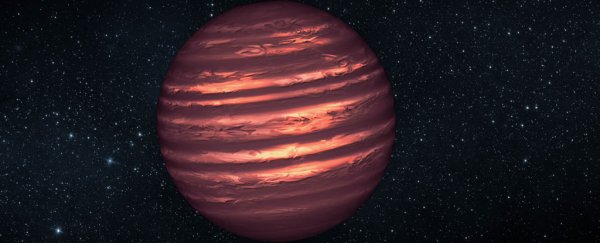New measurements have revealed what scientists think is the purest and most massive brown dwarf ever – a 'failed star' that's almost completely made up of pure hydrogen and helium.
Brown dwarfs are huge celestial objects that lie somewhere in between active stars and planets. They're called failed stars because they don't have enough mass to sustain the nuclear fusion reaction that converts hydrogen to helium, which enables stars to 'shine' and release energy.
In this case, the object is called SDSS J0104+1535, and is located some 750 light-years away in the Pisces constellation. But while this brown dwarf failed to become a star, it's a record-breaker in other ways, consisting of more than 99.99 percent hydrogen and helium.
According to a team led by the Institute of Astrophysics in the Canary Islands, that acute hydrogen and helium purity – and lack of metal elements among its gases – makes SDSS J0104+1535 approximately 250 times purer than our Sun, and scientists have never identified such an extreme case before.
"We really didn't expect to see brown dwarfs that are this pure," says astrophysicist ZengHua Zhang.
The object was first detected as far back as 1992 by the Digitised Sky Survey II and has been observed in other surveys since, but before now, researchers had categorised SDSS J0104+1535 as an M class dwarf – the coolest kind of star that can still burn successfully.
But new readings taken by Zhang and his team using the European Southern Observatory's Very Large Telescope (VLT) in Chile suggest that SDSS J0104+1535 has much lower metallicity than M class stars usually contain.
This means we're looking at an even-cooler L-class dwarf – a kind of brown dwarf that can't kickstart nuclear fusion – and it's the most massive failed star scientists have discovered.
The new measurements suggest SDSS J0104+1535 has a mass equivalent to 90 times that of Jupiter, and the researchers estimate the object formed as far back as 10 billion years ago, which would also put it among the oldest brown dwarfs we've discovered.
Before recently, scientists weren't aware that brown dwarfs could form from such a pristine mixture of hydrogen and helium – but now that we know about SDSS J0104+1535, it's possible that it's just the first of several lurking out there in space.
Of course, just because they're out there doesn't mean identifying them will be easy. Due to their coolness, brown dwarfs are notoriously hard to pick up, as their radiation output is significantly weaker than stars.
But that doesn't mean we shouldn't be trying to find every failed star we can.
Among old brown dwarfs like SDSS J0104+1535, their ancient, primordial gases hold the promise of teaching us more about conditions in the early Universe.
And research published last year even suggested that the upper atmospheres of brown dwarfs could provide a potential habitat for alien lifeforms.
For his part, Zhang is optimistic that more pristine brown dwarfs like SDSS J0104+1535 will be discovered, and it might just be a matter of time.
"Having found one though often suggests a much larger hitherto undiscovered population," says Zhang.
"I'd be very surprised if there aren't many more similar objects out there waiting to be found."
The findings are reported in Monthly Notices of the Royal Astronomical Society.
